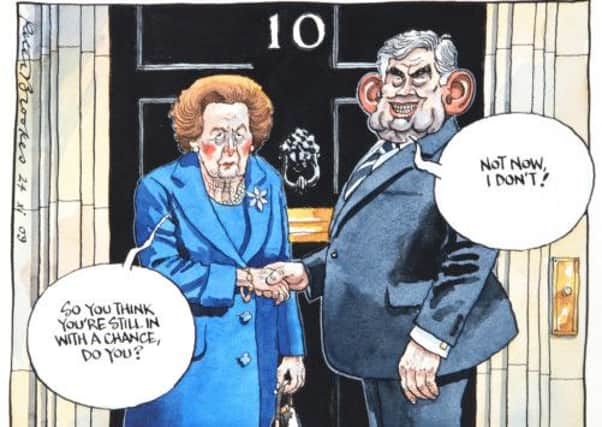Portraits of an Iron Lady


Denis Healey once said of Baroness Thatcher that she approached the problems of the country “with all the subtlety of a comic strip”.
While the grocer’s daughter from Grantham who ended up in Number 10 via Oxford University disagreed with almost everything the Labour stalwart stood for, on this point they might just have found some common ground. Under her rule, she turned treading on toes and ruffling feathers into an art form.
Advertisement
Hide AdAdvertisement
Hide AdIt was not long after she walked into Downing Street that May morning of 1979 that the country’s newspaper cartoonists knew they were onto a good thing.
As Thatcher grew into her role as Britain’s first female Prime Minister the tabloids and the broadsheets either championed her as a hero or condemned her as a villain. To some she was the epitome of the British bulldog ready to take on any enemy; to others she was the wolf in exquisite royal blue tailoring. As the years wore on, those caricatures became ever more sharp.
“The funny thing with newspaper cartoons is that they are there today and gone tomorrow; you rarely get to see the chronology of the subject matter,” says Chris Beetles, who is staging an exhibition of cartoons featuring Lady Thatcher at Leeds Gallery. “However, when you bring them all together what you get is a social and historical narrative of Britain during a particular period and that’s particularly true with someone like Lady Thatcher.”
The seeds of the current exhibition were sown 12 years ago when Chris bought a collection of cartoons from Lord McAlpine. Over quarter of a century, the former party treasurer and deputy chairman of the Conservative Party had built up an impressive archive of JAK cartoons which had first appeared in the London Evening Standard and those, together with work from the likes of Kal, whose cartoons have appeared in the Observer and the Mail on Sunday, the Daily Telegraph’s Matt and Peter Brookes from The Times form the basis of the exhibition.
Advertisement
Hide AdAdvertisement
Hide Ad“The work runs from when she was Education Secretary and earned the nickname the ‘milk snatcher’ right through her premiership,” says Chris.
“Lady Thatcher was Prime Minister for 11 years and what a decade or so it was. It was a period which changed Britain forever.
“From the Miners’ Strike to the Falklands War to the battles with the EEC and the Poll Tax riots to finally her defeat and resignation, there was rarely a quiet moment in the reign of Mrs T.
“People talk today of the public being overwhelmed by political apathy, but that wasn’t so then. Ask anyone what they thought of Lady Thatcher and the responses you will get sit at each end of the spectrum.
Advertisement
Hide AdAdvertisement
Hide Ad“Some people loved her, some hated her, few viewed her with disinterest.”
The exhibition shows Lady Thatcher as the woman who successfully buried the Labour Party until its reinvention by Tony Blair and Co and the PM who doggedly pursued Britain’s interests abroad. However, they also show her as the barbarian determined to rip the heart out of the NHS and who trampled on those who failed to agree with policies.
However, as her iron grip on Number 10 weakened, those disparate portrayals of Lady Thatcher gave way to a more universal caricature. By the time she was deposed, both the red tops and broadsheets had decided that Britain’s Prime Minister was out of control.
“What becomes very clear when you look at the cartoons is how perceptions of her changed,” says Chris, who owns a gallery in London. “Fast forward to her latter years in power and suddenly she was being portrayed as a wild-eyed tyrant. She had become a rampaging Boudicca, who wanted to hang on to power at any cost and who feared the knives were out.”
As it turned out, of course, she was right.
Advertisement
Hide AdAdvertisement
Hide AdBy the September of 1990, Labour was well ahead in the opinion polls and while Thatcher herself had never worried herself with ratings, there was increasing disquiet within her cabinet of once loyal ministers. It was the resignation of Geoffrey Howe which sparked the bitter leadership battle and when Lady Thatcher left Downing Street for the final time on November 8, 1990, the tears she shed were the first sign of emotion many had seen her display in all her years in power.
“We sell a lot of political prints and the people who buy cartoons featuring Lady Thatcher aren’t necessarily supporters of the Conservative Party, in fact many are dyed in the wool Labour voters,” says Chris. “
Both Gerald Scarfe and Ralph Steadman are conspicuous by their absence in the exhibition. “They don’t like having their work displayed alongside that of other cartoonists,” says Chris. “It’s a shame as collectively I think it’s a genre which provides a real snapshot of Britain, but with around 70 individual cartoons I think we have her life and times pretty much covered.”
Margaret Thatcher Cartoons, Leeds Gallery, to August 31. 0113 243 3266, www.leedsgallery.com